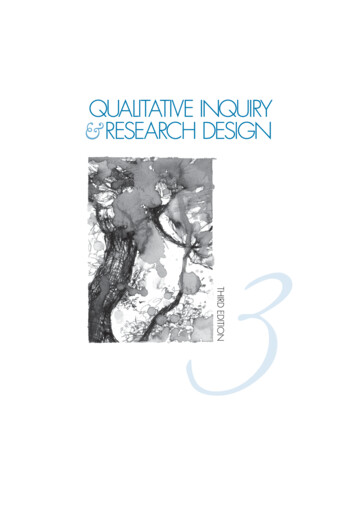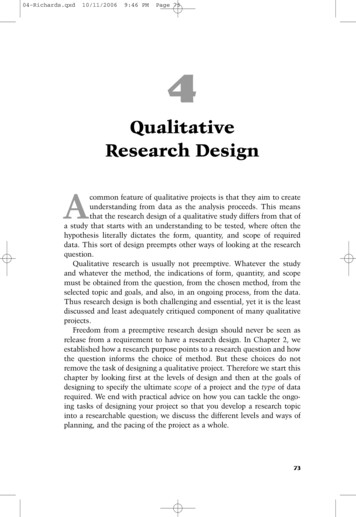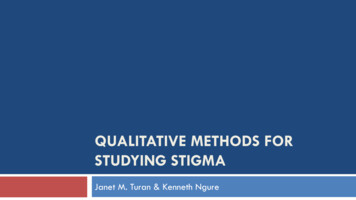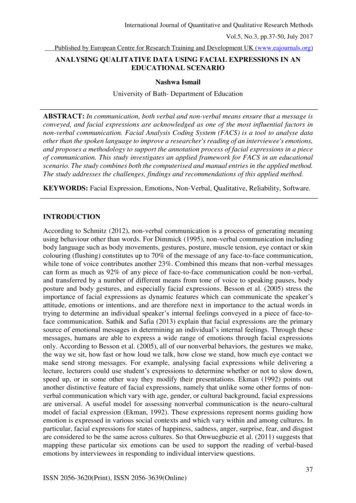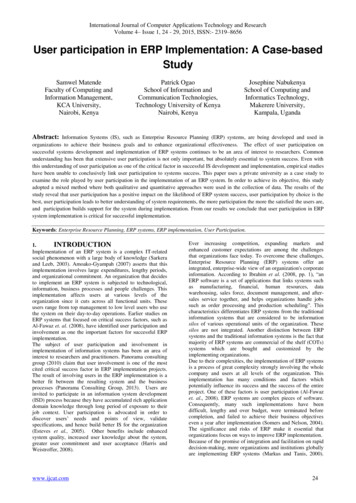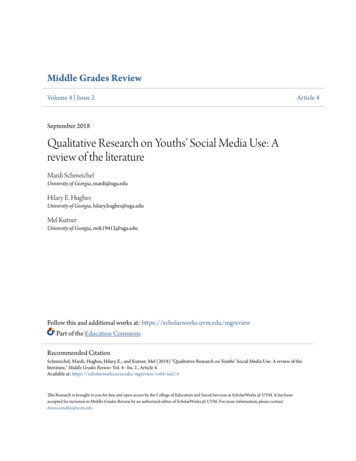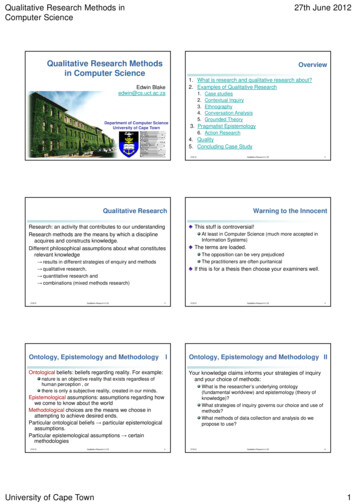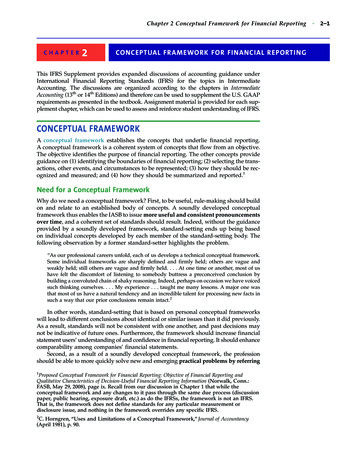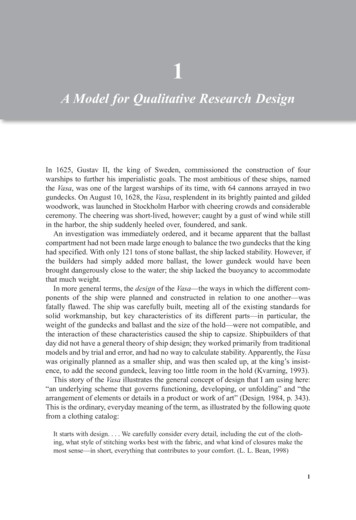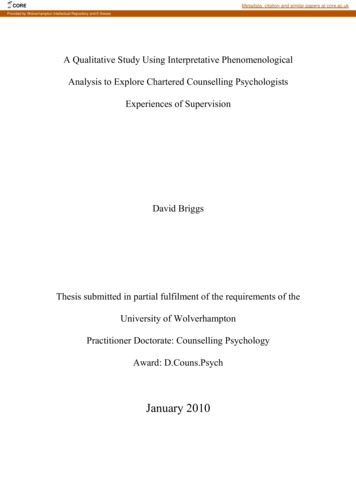
Transcription
COREMetadata, citation and similar papers at core.ac.ukProvided by Wolverhampton Intellectual Repository and E-thesesA Qualitative Study Using Interpretative PhenomenologicalAnalysis to Explore Chartered Counselling PsychologistsExperiences of SupervisionDavid BriggsThesis submitted in partial fulfilment of the requirements of theUniversity of WolverhamptonPractitioner Doctorate: Counselling PsychologyAward: D.Couns.PsychJanuary 2010
DeclarationThis work, or any part thereof, has not previously been presented in any form to theUniversity or to any other body whether for the purposes of assessment, publication orany other purpose.Other than the expressed acknowledgements and references cited in the work, Iconfirm that the intellectual content of the work is the result of my own efforts and ofno other person.The right of David Briggs to be identified as author of this work is asserted inaccordance with ss.77 and 78 of the Copyright, Designs and Patents Act 1988. At thisdate copyright is owned by the author.Signature Date 1
SummaryThis thesis comprises three main sections: a literature review, research report and acritical appraisal of the research process. The literature review is generic across anumber of health professions and begins by placing supervision within its historicalcontext followed by an attempt to clarify our current understanding of supervision.The literature relating to effective supervision is presented, with the supervisoryworking alliance being identified as potentially one of the most important commonfactors in the change process of supervision (Ellis, 1991). A review of supervisionmodels suggests that they provide a structure for understanding the roles,relationships, responsibilities and processes integral to the practice of supervision.The review attempts to clarify the current state of supervision training, highlightingthe lack of attention that has been paid to the process by which individuals learn tobecome effective supervisees and supervisors. It is concluded that there is a need forfurther research in the area of training for both supervisees and studyusinginterpretativephenomenological analysis to explore the supervision experiences of six CharteredCounselling Psychologists. The thematic content that emerged indicated a lack ofpreparation for the role of supervisee and a lack of formal training for the supervisoryrole. The findings revealed that the participants relied upon self-directed learning,their previous experience and their therapeutic skills to inform their supervisorypractice. The findings also highlighted the critical role of the supervisory relationshipfor both supervisee and supervisor in managing the anxieties generated by this lack ofpreparation and training as well as in supporting the learning and development of allinvolved in the relationship.2
The final section is the researcher’s critical appraisal of the research process.This thesis conforms to the format of the peer reviewed journal PsychotherapyResearch (see Appendix 1 for a copy of Notes for Contributors).3
AcknowledgementsI would like to start by thanking my wife Katie and children Benjamin and Rosie forall the love and support that they have given me throughout my research journey.Rosie joined us half way through and she has been a wonderful addition to the team!Their unwavering belief has carried me through those difficult periods and enabledme to complete this project.I would also like to say a special thank you to my mum and dad. I know that youhave never stopped believing in me and the strength I draw from this is immeasurable.I thank my supervisor, Dr Nicky Hart for her support and guidance and I am gratefulto the participants, without which this research would not have been possible.Finally, I feel that it is appropriate at this point to pay my respects to my firstsupervisor, who died in July 2007. As a trainee on his first placement I could nothave asked for a more generous or encouraging supervisor.His belief in thehumanistic philosophy taught me a great deal and I shall be forever grateful for hissupport and guidance both at a personal and professional level. He sowed the seedsfor this research paper in a supervision session in 2006 and I hope that he would bepleased with the outcome.4
Literature Review Search StrategyThe books and journal articles used as reference material were accessed using a rangeof modern techniques.Many of the journal articles were obtained using searchengines such as Athens, Psych Info and Swetswise to access international scientificelectronic journal databases. The internet was also searched using the search enginesGoogle and Google Scholar. The following keywords were used in searches: clinicalsupervision; supervision; supervisee; supervisor; transition; training; experience;counselling; relationship; interpretative phenomenological analysis; effective;preparation; becoming; supervisory working alliance; good; bad. Searches were alsomade of the OPAC catalogue at the university and the NHS Trust library where theresearcher was on placement. Articles were obtained from the electronic databasesthat offered full-text, from journals held by the university, the NHS Trust Library andsome were ordered from the British Library.5
ContentsSECTION 1 – LITERATURE REVIEW .7Abstract .8Introduction 9Types of Supervision .11What is meant by Supervision? .13The Supervisory Working Alliance .15Supervisory Style .17Models of Supervision .20Training and Supervision .29Effectiveness of Supervision Training .38Implications for Future Research . . 40Critical Evaluation of the Research Literature .42References . 46SECTION 2 – RESEARCH REPORT . 63Abstract .64Introduction .65Method . 67Results and Discussion 77Research Issues Arising from the Study .147Summary and Conclusions .151Recommendations for Practice .156Suggestions for Future Research .160SECTION 3 CRITICAL APPRAISAL OF THE RESEARCH PROCESS .169References . 169Appendices 1846
SECTION 1LITERATURE REVIEW7
AbstractIn recent years there has been a significant increase in the research and theoreticalpublications on supervision (Carroll, 1996; Gazzola & Theriault, 2007; Majcher &Daniluk, 2009) and this literature review surveys some of these publications. Thereview is generic across a number of health professions and begins by placingsupervision within its historical context, followed by an attempt to clarify our currentunderstanding of supervision. Identified as the most critical element in supervision(Ellis, 1991), the supervisory working alliance and the different supervisory stylesemployed are then examined followed by an exploration of supervision models. Hartand Nance (2003) suggest that these models provide a structure for understanding theroles, relationship, responsibilities and processes integral to the practice ofsupervision. Finally, literature relating to supervision training is reviewed with theassessment that much of the attention to date has been focused on supervisor training,with little attention having been devoted to supervision training for supervisees. Thisliterature review concludes that there is a need for further research in the area oftraining for both supervisors and supervisees and that an interesting focus for futureresearch would be to explore the supervision experiences of Chartered CounsellingPsychologists.8
IntroductionClinical supervision originated as part of the training process in psychoanalysis (Page& Wosket, 1994).Fleming and Benedek (1983) describe the development ofpsychoanalytic supervision from the twenties through to the mid-sixties. Within theirtradition, supervision was an integral part of the training process that complementedthe theoretical teaching and the analysis of the fledgling analyst (Buckley, Conte,Plutchik, Karasu, & Wild, 1982). These three elements (supervision, teaching andpersonal analysis) of the training process were made a formal requirement by theInternational Training Commission in 1925. More recently, the British Associationfor Counselling and Psychotherapy (BACP) states that “All counsellors,psychotherapists, trainers and supervisors are required to have regular and on-goingformal supervision/consultative support for their work in accordance withprofessional requirements” (BACP, 2009: Ethical Framework for Good Practice inCounselling and Psychotherapy, p. 5). In their Guidelines for Supervision (BritishPsychological Society, 2007) the Division of Counselling Psychology states that“Supervision is a requirement for every Counselling Psychologist and covers allaspects of their professional life” (BPS, 2007, p. 5).The Professional PracticeGuidelines (BPS, 2005) of the Division of Counselling Psychology require aminimum of one and a half hours per month.In November 2007, the Health Secretary, Alan Johnson, announced the ImprovingAccess to Psychological Therapies (IAPT) programme together with 170 million ofextra investment in psychology services including the training of an extra 3600therapists. The IAPT programme represents a major expansion in the provision ofpsychological therapies; between 2008 and 2011 there will be a rapid increase in the9
number of individuals expected to deliver high quality therapeutic interventions. Thisunprecedented growth means that training and supervision are integral to the IAPTagenda and within the programme supervision is described as a key activity, whichwill determine the success of the IAPT programme. This emphasis on supervision hasled to the commissioning of training for all IAPT supervisors using the competencesframework for supervision (Roth & Pilling, 2007; 2008).It is clear from the literature that supervision is viewed as an increasingly importantpart of training within the health professions. It is evident that one of the mainreasons for this growth in importance is that with increased development andprofessionalism within health care, there is greater focus on assessment andmeasurement of clinical work at all levels. First, this is true at the client level becausethere is more focus on diagnostic criteria to assess the client and more emphasis ondeveloping specific treatment goals and outcomes, often accompanied by time frames(Craig, Gonsalvez & McLeod, 2008; Getz, 1999).Second, there is a need to assess and evaluate health professionals (Craig, Gonsalvez& McLeod, 2008). Clinical supervisors in academic training programs and in thefield are required to provide this evaluation. Supervisors' ultimate responsibility is toclients, and therefore they must ensure that health professionals in training areaccurately assessing clients' needs and their progress. But supervisors must also carrya responsibility for the supervisees' learning and professional identity, and they arecharged with serving as gatekeepers to the health profession (King & Wheeler, 1999).Clinical supervision is increasingly seen as a critical component in a healthpractitioner’s development across the professional lifespan beyond academic training10
programmes and initial professional positions. Government health departments areshifting more responsibility to supervisors who must attest to their supervisees'competence (Getz & Agnew, 1999). Finally, at the highest level in the hierarchy,educators who are training supervisors must evaluate these supervisors (Getz, 1999).The literature suggests that supervision has become a separate process with its ownconceptual framework and methodology and defining supervision is challenginglargely because the content and structure of supervision varies with professionalgrouping, therapeutic orientation and clinical context.Types of SupervisionThere are many definitions of supervision that reflect the way in which it isunderstood by different professions in different contexts and before looking atsupervision in more detail, a few different types of supervision need to be outlined. Ingeneral there are four types of supervision (Hawkins & Shohet, 2006, p. 60):Tutorial supervisionSupervision here is characterised by a mentor relationship where a supervisor mayhave more of a tutor role, concentrating almost entirely on the developmental functionof supervision. For example, overseeing someone who is engaged in completing aresearch thesis or work project.11
Trainee supervisionThis type of supervision deals with those in training and also emphasises thedevelopmental function of supervision. The supervisee will be in some form oftraining or apprenticeship role.The supervisor in this instance will have someresponsibility for the work being done with the clients and is also part of theassessment process that moves a trainee towards qualification.Managerial supervisionThis term is used where the supervisor is also the line manager of the supervisee. Asin training supervision the supervisor has some clear responsibility for the work beingdone with clients, but supervisor and supervisee will be in a manager-subordinaterelationship, rather than a trainer-trainee one.Consultancy supervisionHere the supervisees keep the responsibility for the work they do with their clients,but consult with their supervisor, who is neither their trainer/nor manager, on thoseissues they wish to explore. This form of supervision is for experienced and qualifiedpractitioners.Carroll (2007) suggests that consultancy supervision represents what we have calledclinical supervision and in defining it Carroll (2007) suggests that: “Clinicalsupervision pertains to circumstances where the work of the practitioner is the focusof the meeting between supervisee and supervisor and where the supervisor has noother relationship with the supervisee other that the supervision relationship”.(Carroll, 2007, p. 433).12
What is meant by Supervision?In attempting to define supervision in general across professions Carroll (2007)suggests that: “At its simplest, supervision is a forum where supervisees review andreflect on their work in order to do it better.In a relationship of trust andtransparency, supervisees talk about their work and through reflection andthoughtfulness learn from it and return to do it differently”. (Carroll, 2007, p. 433434).Ryan (2004) argues that supervision is an inquiry into practice. “It is a compassionateappreciative inquiry in supervision we re-write the stories of our own practice .supervision interrupts practice. It wakes us up to what we are doing. When we arealive to what we are doing we wake up to what is, instead of falling asleep in thecomfort stories of our clinical routines”. (Ryan, 2004, p. 44).In their Guidelines for Supervision (BPS, 2007) the Division of CounsellingPsychology state that “Supervision is a cornerstone of Counselling Psychologytraining and practice and a requirement of every practitioner, however senior,throughout their working life” (BPS, 2007, p. 3).Wheeler and Richards (2007) suggest that supervision is a formal relationship inwhich there is a contractual agreement that the therapist will present their work withclients in an open and honest way that enables the supervisor to have insight into theway in which the work is being conducted. The supervisor is understood to beaccountable to the professional body to which the supervisee has allegiance (Wheeler,2003). Inskipp and Proctor (2001) suggest that supervision is a working alliance13
between supervisor and counsellor that enables the counsellor to gain ethicalcompetence, creativity and compassion in order to deliver the best possible service tothe client.A classic definition of supervision that is often quoted is provided by Bernard andGoodyear (2004) who say that: “Supervision is an intervention provided by a moresenior member of a profession to more junior member or members of that sameprofession. The relationship is evaluative, extends over time and has the simultaneouspurposes of enhancing the professional functioning of the more junior person(s),monitoring the quality of professional services offered to the client, she, he or theysee, and serving as a gatekeeper of those who are to enter the particular profession.”(Bernard & Goodyear, 2004, p. 8). Wheeler and Richards (2007) argue that thisdefinition does not capture the essence of the complexity of the supervision process,tasks, roles and functions in all settings.There is general agreement in the literature that supervision represents a workingalliance between two or more professional members in which the aim is to achieve arange of goals that can be broadly categorised into themes relating to (a)organisational/administrative functions, (b) clinical practice, and (c) provision ofpersonal support to the employee (Gazzola & Theriault, 2007; BPS, 2007). The overriding aim is to optimise the service provided to clients, in line with the goals,expectations, and ethical and professional standards of the organisation and professionconcerned (BPS, 2007). The process and practices of supervision are designed toenhance those skills, knowledge, attitudes, competencies, and practices of staff inorder to achieve these ultimate goals.14
An in-depth understanding of what events constitute effective supervision asexperienced by both supervisees and supervisors is necessary if one is to fullycomprehend the relevant and crucial aspects of supervision that contribute to theacquisition of therapeutic skills and the development of a professional identity(Gazzola & Theriault, 2007; Worthen & McNeill, 1996).The Supervisory Working AllianceThe quality of the supervisory relationship is key in the delivery of effectivesupervision as perceived by supervisors and supervisees (Vallance, 2004) andaccording to several theorists (Bordin, 1983; Efstation, Patton & Kardash, 1990), thesupervisory working alliance is potentially one of the most important common factorsin the change process of supervision. Ellis (1991) indicated that the supervisoryrelationship was identified as the most critical element in supervision by thesupervisee, whilst Holloway (1987) asserted that the supervisory relationship may bethe most vital mechanism of change in the supervisee from initial vulnerability tofinal independence.Ladany (2004) argues that Bordin’s (1983) model of thesupervisory working alliance is the foundation for determining the effectiveness ofsupervision.Bordin (1983) compared the supervisory alliance to the therapeutic alliance incounselling and claimed that the supervisory working alliance consists of threecomponents and involves collaboration between trainee and supervisor to worktoward change. These three components are a mutual agreement on the goals ofsupervision (e.g., mastery of specific counselling skills), mutual agreement on the15
tasks needed to reach the goals of supervision (e.g., observing counselling skills inaudiotapes), and an emotional bond involving mutual liking and caring between thesupervisor and the trainee. A unique feature of the supervisory working alliance isthat the relationship is considered to be based on perceptions of mutual connectionsbetween supervisors and trainees.In other words, the supervisor perceives thatmutual trust exists with the trainee, rather than a unidirectional notion of trust (e.g.,supervisor trusts the trainee). Furthermore, Bordin's model has offered researchers avaluable and cogent conceptualisation of the supervisory relationship (Bernard &Goodyear, 1998; Muse-Burke, Ladany & Deck, 2001; Pachankis & Goldfried, 2007).Ladany (2004) conducted a number of studies to explore the relationship between thesupervisory working alliance and supervision process and outcome. Results fromthese studies indicated that a strong supervisory working alliance is significantlyrelated to supervisor adherence to ethical guidelines (Ladany, Lehrman-Waterman,Molinaro & Wolgast, 1999), trainee satisfaction (Ladany, Ellis & Friedlander, 1999),supervisor self-disclosure (Ladany & Lehrman-Waterman, 1999) and supervisortrainee racial identity interactions (Ladany, Brittan-Powell & Pannu, 1997). It is alsorelated to trainee experience of role conflict and role ambiguity (Ladany &Friedlander, 1995), effective evaluation practices (Lehrman-Waterman & Ladany,2001), a balanced supervisory approach consisting of collegial, interpersonallysensitive and task –oriented styles (Ladany, Walker & Melincoff, 2001), increasedtrainee self-disclosure (Ladany, O’Brien, Hill, Melincoff, Knox & Peterson, 1997;Walker, Ladany & Pate-Carolan, 2003), trainee sexual attraction toward thesupervisor (Melincoff, Ladany, Walker, Muse-Burke & Tyson, 2003) and supervisorystyle (Efstation et al., 1990).16
Gazzola and Theriault (2007) investigated the impact of positive and negativeexperiences in the supervisory process from the perspective of supervisees.Participants in their study valued supervisors who were non-judgmental, empathic andempowering and all supervisees stated that the supervisors who created a safe andnurturing supervisory environment facilitated a positive experience of supervision.In conclusion the research indicates that the supervisory working alliance influencessupervision process and outcome in crucial ways and that supervisors should attend tothe development of a strong supervisory alliance using a generalising of theirtherapeutic skills (Ladany, 2004).Supervisory StyleA number of researchers have identified supervisory style as a key component of thesupervisory working alliance (Carroll, 1996; Efstation et al., 1990; Ladany, 2004).Supervisory style refers to clearly identifiable and consistent patterns of behavioursand techniques, attitudes, and philosophies used by supervisors in their supervisionpractices (Shanfield, Mohl, Matthews & Hetherly, 1992; Ladany et al., 2001). Severalstudies have tried to identify styles of supervision that are most effective for particulartypes of supervisees and settings. For example, it has been hypothesised that theoptimal supervisory style will vary according to the supervisee's stage of careerdevelopment, learning style, type of presenting client problem, and preferred clinicalorientation (Heppner & Roehlke, 1984). Developmental models of supervisionpropose that, as supervisees develop professionally, their supervision needs changeaccordingly (Tryon, 1999). Stoltenberg and McNeill (1997) suggest that supervisors17
should primarily adopt a teacher role with beginning trainees and primarily aconsultant role with advanced trainees.Heron (1990) proposed that supervision styles can be broadly categorised intoauthoritative or facilitative approaches. Authoritative styles include prescriptive(advice and explicit direction of the supervisee by the supervisor), informative(supervisor imparts knowledge and information to the supervisee), and confrontative(clear, direct feedback regarding behaviour, and challenging beliefs and attitudes)supervisor behaviours. Facilitative styles include cathartic (supervisor enablessupervisee to release tensions and emotions), catalytic (supervisor encouragessupervisee to be reflective and self-directive), and supportive (supervisor confirmsand validates the supervisee's values and worth). Other authors have proposeddifferent classifications of supervisory style, but these generally overlap with or maybe subsumed within the system proposed by Heron (1990). For example, Cherniss andEgnatios (1977) described five supervisory patterns, termed authoritarian, insightoriented, laissez-faire, didactic-consultative, and feelings styles. Similarly, Shanfieldand Gil (1985) identified four basic supervisory styles, namely task-oriented, expert,confrontative/directive, and facilitative.Friedlander and Ward (1984) defined supervisory style as the different approachesthat supervisors use, in combination with their distinctive manner of responding totrainees. Specifically, they identified three interrelated supervisory styles: attractive,interpersonally sensitive, and task-oriented. These styles coincide with Bernard's(1997) three basic supervisor roles of interacting with trainees: consultant, counsellor,and teacher. These styles can be further defined as follows. First, supervisors who18
adopt an attractive style tend to be warm, friendly, open, and supportive toward theirtrainees. The attractive style is similar to Bernard's (1997) collegial or consultantsupervisor role. Supervisors who adopt an interpersonally sensitive style tend to beinvested, therapeutic, and perceptive when working with their trainees, which issimilar to Bernard's (1997) counsellor role. Finally, supervisors who engage in a taskoriented style tend to be focused, goal oriented, and structured during supervision,which coincides with Bernard's (1997) teacher role.Bernard (1997) identified “support” and “direction” as supervisor behaviour thatunderlies all of the various styles of supervision. Support refers to those behavioursthat show empathy and build rapport with the supervisee. Direction refers to thosebehaviours that question, instruct, or challenge the supervisee. By understanding therelationship of support and direction with the approaches to providing supervision,counsellor educators and supervisors may be better able to teach students to use theseapproaches and to evaluate their effectiveness (Ladany, Walker & Melincoff, 2001).Shanfield, Hetherly and Mathews (2001) identified the sort of behaviours associatedwith good supervision. “Good” supervisors tended to allow the supervisee’s story todevelop, track the most immediate concerns and queries of the supervisee and makecomments that were specific to the material being presented. In contrast, poorersupervision seemed to occur when supervisors were less disciplined in maintaining afocus on supervisee’s concerns, were less structured and paid little or no attention tosupervisee concerns.19
Although considerable emphasis has been placed on the need for supervisors to adapttheir supervisory style to the characteristics of the supervisee (e.g., cognitive style orlevel of experience), Joshi and McAllister (1998) reported that this does not tend tohappen in practice. Rather, supervisors develop a preferred style of supervision that isrelatively consistent across settings and supervisees. Indeed, even when supervisorsreport that they change their supervisory style according to supervisee characteristicsand believe that this is important, their behaviour tends to remain the same. Thus,supervisors are not accurate reporters of their own behaviour, bringing into questionthe validity of data based on supervisor reports alone. Research into the nature andeffectiveness of different supervisory styles therefore needs to ensure that theevidence is based on reliable and valid measures of supervisor behaviour. To date,although researchers have identified characteristic patterns of supervision practices,sound methodological research has not been conducted to allow us to identify whichsupervision practices are most effective with particular types of supervisees (Ladany,2004).Models of SupervisionIn order to evaluate the effectiveness of supervision and to teach students to conducteffective supervision, counsellor educators and supervisors must have cleardefinitions of the various approaches that can be used and a theoreticalconceptualisation into which these approaches are logically integrated (Hart & Nance,2003).Models of supervision provide a structure for understanding the roles,relationship, responsibilities and processes integral to the practice of supervision. Forexample, in the process model of supervision (Hawkins & Shohet, 2000), focus on the20
therapist has equal importance to all other aspects of supervision (Wheeler &Richards, 2007).The past 30 years has seen a proliferation of models of supervision (Ladany, Ellis &Friedlander, 1999), which critics suggest have contributed little to the implementationand practice of supervision (Borders, 1989). Indeed, Borders (1989) called for amoratorium on new models of supervision, although this request had minimal impactand the literature continues to proliferate with authors presenting their theoretical,philosophical, and practical views in the area (Spence et al. 2001).Typically, models emphasise some theoretical position, therapeutic orientation,purpose, content, style, and/or process in relation to supervision. Some models ofsupervision developed from the premise that the process of supervision should bebased on the same change methods and theoretical principles as a particular form oftherapy. These approaches include solution-focused (Rita, 1998), humanistic(Farrington, 1995), psychodynamic (Rodenhauser, 1995), and counselling (Leddick &Bernard, 1980) models of supervision.In relation to the current study, it was felt important to review the literature pertainingto models of supervision in order to understand how they influence the role of thesupervisor and also the experience of the supervisee. Various models have attemptedto explain the process of change that occurs with increased training and thesubsequent effect on the supervisory relationship. Generally the models propose thatsupervisees will exhibit different characteristics and abilities based on accruedexperience (Bernard & Goodyear, 1998). A detailed description of the many scores21
of supervision models was felt to be beyond the scope of the present review, so sixmodels were reviewed, the
Counselling and Psychotherapy, p. 5). In their Guidelines for Supervision (British Psychological Society, 2007) the Division of Counselling Psychology states that “Supervision is a requirement for every Counselling Psychologist and covers all aspects of their profes
